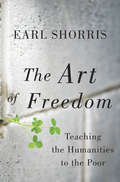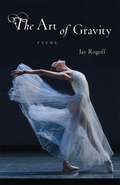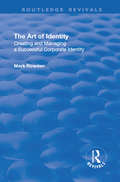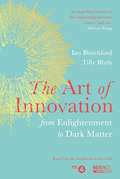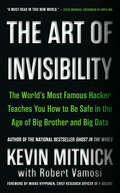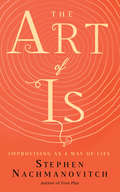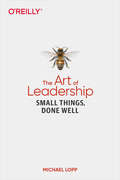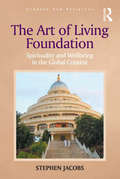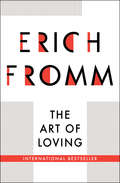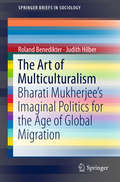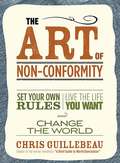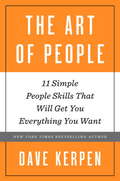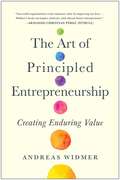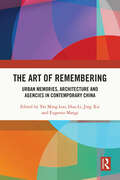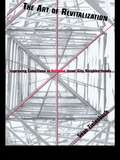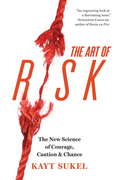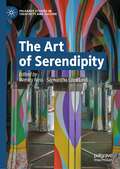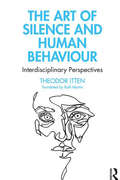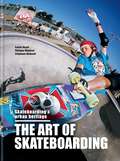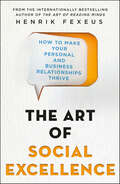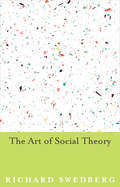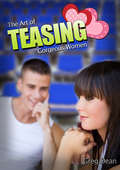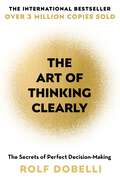- Table View
- List View
The Art of Freedom: Teaching the Humanities to the Poor
by Earl ShorrisA conversation in a prison cell sparks an ambitious undertaking to attack the roots of long-term poverty. Seeking answers to the toughest questions about poverty in the United States, Earl Shorris had looked everywhere. At last, one resounding answer came from a conversation with a woman in a maximum-security prison: the difference between rich and poor is the humanities. Shorris took that idea and started a course at the Clemente Family Guidance Center in New York. With a faculty of friends, he began teaching the great works of literature and philosophy--from Plato to Kant, from Cervantes to Garcia Marquez--at the college level to dropouts, immigrants, and ex-prisoners. From that first class came two dentists, a nurse, two PhDs, a fashion designer, a drug counselor, and other successes. Over the course of seventeen years the course expanded to many U.S. cities and foreign countries. Now Earl Shorris has written the stories of those who teach and those who study the humanities--a tribute to the courage of people rising from unspeakable poverty to engage in dialogue with professors from great universities around the world. This year, in a high school on the South Side of Chicago, a Clemente Course has begun that may change the character of public education in America and perhaps the world.
The Art of Gravity: Poems
by Jay RogoffGeorge Balanchine, one of the twentieth century's foremost choreographers, strove to make music visible through dance. In The Art of Gravity, Jay Rogoff extends this alchemy into poetry, discovering in dancing -- from visionary ballets to Lindy-hopping at a drunken party -- the secret rhythms of our imaginations and the patterns of our lives.The poems unfold in a rich variety of forms, both traditional and experimental. Some focus on how Edgar Degas's paintings expose the artifice and artistic self-consciousness of ballet while, paradoxically, illuminating how it creates rapture. Others investigate dance's translation of physical gesture into allegorical mystery, especially in Balanchine's matchless works. Rogoff pays tribute to superb dancers who grant audiences seductive glimpses of the sublime and to all of us who find in dance a redemptive image of ourselves.The poet reveals dance as an "art of gravity" in the illusory weightlessness of a "dance that ends in mid-air," in the clumsiness of a Latin dance class's members "trip- / ping over each other in the high school / gym," and in the exploration of ultimate Gravity -- a sonnet sequence titled "Danses Macabres." Ultimately, Rogoff confronts with unflinching precision the dark consummation of all our dancing.
The Art of Identity: Creating and Managing a Successful Corporate Identity (Routledge Revivals Ser.)
by Mark RowdenThis title was first published in 2000: This text redefines corporate identity. It offers an insight into the creation, management and measurement of identity - and into why the right identity can transform your organization. With the help of tests and illustrations, Mark Rowden challenges readers to jettison ineffectual compromises and half-baked solutions in order to achieve the identity that really gives an advantage. He focuses on "correct" thinking through the application of design, and presents several management tools which should enable managers to define the fundamental qualities of their organization, to translate them into visual media, and to judge how well a new identity communicates them.
The Art of Innovation: From Enlightenment to Dark Matter, as featured on Radio 4
by Ian Blatchford Tilly BlythBased on the landmark Radio 4 series, this beautifully illustrated modern history of the connections between science and art offers a new perspective on what that relationship has contributed to the world around us. __________ Throughout history, artists and scientists have been driven by curiosity and the desire to experiment. Both have wanted to make sense of the world around them, often to change it, sometimes working closely together, certainly taking inspiration from each other's disciplines. The relationship between the two has traditionally been perceived as one of love and hate, fascination and revulsion, symbiotic but antagonistic. But art is crucial to helping us understand our science legacy and science is well served by applying an artistic lens. How exactly has the ingenuity of science and technology been incorporated into artistic expression? And how has creative practice, in turn, stimulated innovation and technological change?The Art of Innovation is a history of the past 250 years viewed through the disciplines of art and science. Through fascinating stories that explore the sometimes unexpected relationships between famous artworks and significant scientific and technological objects - from Constable's cloudscapes and the chemist who first measured changes in air pressure, to the introduction of photography and the representation of natural history in print - it offers a new way of seeing, studying and interpreting the extraordinary world around us.
The Art of Invisibility: The World's Most Famous Hacker Teaches You How to Be Safe in the Age of Big Brother and Big Data
by Kevin MitnickBe online without leaving a trace.Your every step online is being tracked and stored, and your identity literally stolen. Big companies and big governments want to know and exploit what you do, and privacy is a luxury few can afford or understand. In this explosive yet practical book, Kevin Mitnick uses true-life stories to show exactly what is happening without your knowledge, teaching you "the art of invisibility"--online and real-world tactics to protect you and your family, using easy step-by-step instructions. Reading this book, you will learn everything from password protection and smart Wi-Fi usage to advanced techniques designed to maximize your anonymity. Kevin Mitnick knows exactly how vulnerabilities can be exploited and just what to do to prevent that from happening. The world's most famous--and formerly the US government's most wanted--computer hacker, he has hacked into some of the country's most powerful and seemingly impenetrable agencies and companies, and at one point was on a three-year run from the FBI. Now Mitnick is reformed and widely regarded as the expert on the subject of computer security. Invisibility isn't just for superheroes--privacy is a power you deserve and need in the age of Big Brother and Big Data.
The Art of Is: Improvising as a Way of Life
by Stephen NachmanovitchA MASTERFUL BOOK ABOUT BREATHING LIFE INTO ART AND ART INTO LIFE &“Stephen Nachmanovitch&’s The Art of Is is a philosophical meditation on living, living fully, living in the present. To the author, an improvisation is a co-creation that arises out of listening and mutual attentiveness, out of a universal bond of sharing that connects all humanity. It is a product of the nervous system, bigger than the brain and bigger than the body; it is a once-in-a-lifetime encounter, unprecedented and unrepeatable. Drawing from the wisdom of the ages, The Art of Is not only gives the reader an inside view of the states of mind that give rise to improvisation, it is also a celebration of the power of the human spirit, which — when exercised with love, immense patience, and discipline — is an antidote to hate.&” — Yo-Yo Ma, cellist
The Art of Leadership: Small Things, Done Well
by Michael LoppMany people think leadership is a higher calling that resides exclusively with a select few who practice and preach big, complex leadership philosophies. But as this practical book reveals, what’s most important for leadership is principled consistency. Time and again, small things done well build trust and respect within a team.Using stories from his time at Netscape, Apple, and Slack, Michael Lopp presents a series of small but compelling practices to help you build leadership skills. You’ll learn how to create teams that are highly productive, highly respected, and highly trusted. Lopp has been speaking and writing about this topic for over a decade and now maintains a Slack leadership channel with over 13,000 members.The essays in this book examine the practical skills Lopp learned from exceptional leaders—as a manager at Netscape, a senior manager and director at Apple, and an executive at Slack. You’ll learn how to apply these lessons to your own experience.
The Art of Living Foundation: Spirituality and Wellbeing in the Global Context (Routledge New Religions)
by Stephen JacobsThe Hindu-derived meditation movement, The Art of Living (AOL), founded in 1981 by Sri Sri Ravi Shankar in Bangalore, has grown into a global organization which claims presence in more than 150 countries. Stephen Jacobs presents the first comprehensive study of AOL as an important transnational movement and an alternative global spirituality. Exploring the nature and characteristics of spirituality in the contemporary global context, Jacobs considers whether alternative spiritualities are primarily concerned with individual wellbeing and can simply be regarded as another consumer product. The book concludes that involvement in movements such as AOL is not necessarily narcissistic but can foster a sense of community and inspire altruistic activity.
The Art of Loving (Classics Of Personal Development Ser.)
by Erich FrommThe landmark bestseller that changed the way we think about love: &“Every line is packed with common sense, compassion, and realism&” (Fortune). The Art of Loving is a rich and detailed guide to love—an achievement reached through maturity, practice, concentration, and courage. In the decades since the book&’s release, its words and lessons continue to resonate. Erich Fromm, a celebrated psychoanalyst and social psychologist, clearly and sincerely encourages the development of our capacity for and understanding of love in all of its facets. He discusses the familiar yet misunderstood romantic love, the all-encompassing brotherly love, spiritual love, and many more. A challenge to traditional Western notions of love, The Art of Loving is a modern classic about taking care of ourselves through relationships with others by the New York Times–bestselling author of To Have or To Be? and Escape from Freedom. This ebook features an illustrated biography of Erich Fromm including rare images and never-before-seen documents from the author&’s estate.
The Art of Multiculturalism: Bharati Mukherjee’s Imaginal Politics for the Age of Global Migration (SpringerBriefs in Sociology)
by Roland Benedikter Judith HilberThis book describes what an “art of multiculturalism” could be and how in turn multiculturalism could be conceived as a form of art. It focuses on the early and middle work of Indian-born U.S. writer Bharati Mukherjee, in particular on her understanding of the “fusion” of literature and painting as a tool to inspire the creation of a “new global society” by empowering minorities through fostering and multiplying “differences in unity” and “unities in difference”. The book includes, in condensed ways, an explanation of Mukherjee’s use of ancient Indian painting techniques for postmodern writing; and it provides a short introduction to the relation between multiculturalism, postmodernity and “imaginal politics”. The book is written in an easy to read style accessible to all interested in the topic: high school and university students and teachers; those generally interested in the interface between literature, the arts and politics; and specialists in multicultural studies and global and international studies. The book is particularly suited to use in teaching.
The Art of Non-conformity: Set Your Own Rules, Live the Life You Want, and Change the World
by Chris GuillebeauIf you've ever thought, 'There must be more to life than this,' The Art of Non-Conformity is for you. Based on Chris Guillebeau's popular online manifesto 'A Brief Guide to World Domination,' The Art of Non-Conformity defies common assumptions about life and work while arming you with the tools to live differently. You'll discover how to live on your own terms by exploring creative self-employment, radical goal-setting, contrarian travel, and embracing life as a constant adventure. Inspired and guided by Chris's own story and those of others who have pursued unconventional lives, you can devise your own plan for world domination-and make the world a better place at the same time.
The Art of People: 11 Simple People Skills That Will Get You Everything You Want
by Dave KerpenWhat does it take to win success and influence? Some people think that in today's hyper-competitive world, it's the tough, take-no-prisoners type who comes out on top. But in reality, argues New York Times bestselling author Dave Kerpen, it's actually those with the best people skills who win the day. Those who build the right relationships. Those who truly understand and connect with their colleagues, their customers, their partners. Those who can teach, lead, and inspire. In a world where we are constantly connected, and social media has become the primary way we communicate, the key to getting ahead is being the person others like, respect, and trust. Because no matter who you are or what profession you're in, success is contingent less on what you can do for yourself, but on what other people are willing to do for you. Here, through 53 bite-sized, easy-to-execute, and often counterintuitive tips, you'll learn to master the 11 People Skills that will get you more of what you want at work, at home, and in life. For example, you'll learn: · The single most important question you can ever ask to win attention in a meeting · The one simple key to networking that nobody talks about · How to remain top of mind for thousands of people, everyday · Why it usually pays to be the one to give the bad news · How to blow off the right people · And why, when in doubt, buy him a Bonsai A book best described as "How to Win Friends and Influence People for today's world," The Art of People shows how to charm and win over anyone to be more successful at work and outside of it.
The Art of Principled Entrepreneurship: Creating Enduring Value
by Andreas WidmerHow many times have you heard someone say, "It&’s not personal; it&’s just business"? That attitude reflects a belief that business needs to be cut-throat, that it&’s a dog-eat-dog world, that the pursuit of profit is the only thing that matters, and that the only way to succeed is to beat the competition. But none of this is true: business doesn&’t have to be that way. The Art of Principled Entrepreneurship is a prescription for living the American Dream and for finding the fulfilment that comes from helping employees and customers improve their lives. In his 30-year career in international business strategy, economic development, and entrepreneurship, author Andreas Widmer has seen firsthand numerous companies both succeed financially and also build a people-centered venture in the process. He shares his favorite success stories and details five key principles for conducting business in ways that combine personal virtue, the latest entrepreneurial tools, and long-term perspective in order to make business a win-win proposition for everyone. At a time when the number of new business startups is at its lowest point in 50 years and more than half the workforce at existing businesses struggles with motivation, finding a better way to do business is more urgent than ever. For any entrepreneur, manager, employee, or business student seeking to build people-centered businesses and teams, The Art of Principled Entrepreneurship is an insightful, practical guide to how businesses can be run to be both virtuous and profitable.
The Art of Professional Communication: Strategies that Advance Careers
by Daniel PlungGoing beyond the mechanics of professional communication, this book combines insights into the overlooked implicit demands of corporate communication challenges with the proven strategies and techniques that distinguish professionals as capable communicators and candidates for promotion.The practical strategies offered in this book represent professional communication principles filtered through the lens of the author’s 40-year career, that enabled him to rise from an initial assignment as a technical editor to positions of senior management directing large, diverse business and technical organizations. Here, he has collected into one resource the reasoned and disciplined decision-making processes, tools, and techniques essential to craft communications, precisely attuned to the explicit and implicit expectations of each assignment and supported by a structure and presentation logic that delivers a totally responsive and accurately targeted product. This is an essential guide for all levels of professionals who recognize the need to distinguish themselves within a highly competitive career environment.Business professionals and instructors in corporate training programs, supervisors and managers, and students in professional communication programs will welcome this deep dive into the real-world challenges and opportunities in professional communication and the role effective communication plays in career advancement.
The Art of Remembering: Urban Memories, Architecture and Agencies in Contemporary China
by Hua Li Jing Xie Yat Ming Loo Eugenio MangiFocusing on the non-Western context and case studies, this book explores theories of interdisciplinary architectural thinking and the construction of urban memory in Chinese cities, with an emphasis on contemporary architecture and the diversity of agencies.China has undergone one of the fastest urbanisation and urban renewal processes in human history, but discussions of urban memory in China have tended to be practice-oriented and lack theoretical reflection. This book brings together interdisciplinary architectural scholarship to interrogate the production of urban memory and examine experiences in China. The 14 chapters explore different processes, projects, materials, architecture and urban spaces in different Chinese cities by analysing cityscapes such as temples, bridges, conservation projects, architectural design, historical architecture, memorial hall, market street, city images, custom bike, food market and so on. The book deals with different agencies and methods, tangible and intangible, in the construction of memories aimed at promoting hybridised multiple identities, and explores the interplay of different versions of memory, i.e. state, public, regional, local, individual and collective memory.This book will be essential reading for scholars and students of architecture and urbanism, cultural studies and China studies, as well as architects, urban planners and historians interested in these fields.
The Art of Revitalization: Improving Conditions in Distressed Inner-City Neighborhoods (Contemporary Urban Affairs #Vol. 12)
by Sean ZielenbachThis book discusses the revitalization of decayed inner-city neighborhoods. It explores the role of social capital in stabilizing and turning around distressed communities, and it highlights the roles that local actors can and do play in the revitalization process.The Art of Revitalization takes two Chicago neighborhoods, Englewood and North Lawndale, as case studies. Zielenbach discusses them in the context of racial change and urban decay in Chicago since World War II. The account of the changing neighborhoods is fascinating and clear, and the strength of the author's portrayal of Chicago's transformation sets the stage for his detailed analysis.
The Art of Risk
by Kayt SukelAre risk-takers born or made? Why are some more willing to go out on a limb (so to speak) than others? How do we weigh the value of opportunities large or small that may have the potential to change the course of our lives? These are just a few of the questions that author Kayt Sukel tackles, applying the latest research in neuroscience and psychology to compelling real-world situations. Building on a portfolio of work that has appeared in such publications as Scientific American, Atlantic Monthly, The Washington Post, and more, Sukel offers an in-depth look at risk-taking and its role in the many facets of life that resonates on a personal level. Smart, progressive, and truly enlightening, The Art of Risk blends riveting case studies and hard-hitting science to explore risk-taking and how it impacts decision-making in work, play, love, and life, providing insight in understanding individual behavior and furthering personal success.From the Hardcover edition.
The Art of Serendipity (Palgrave Studies in Creativity and Culture)
by Samantha Copeland Wendy RossSerendipity and creativity are both broad, widely disputed, and yet consistently popular concepts which are relevant to understanding the positive aspects of our daily lives and even human progress in the arts and sciences. The chapters in this book reflects a variety of theoretical and practical approaches to serendipity in various domains, including creative problem solving, sculpture, writing, theatre and design. Chapter authors address issues such as the nature of the ‘prepared mind’, the role of accidents, serendipity as a skill or way of engaging with the world and, indeed, how serendipity works as a concept and practice in relation to the dynamic flow of the creative system. Those who wish to explore the nature of chance in art and creativity, as well as in their daily lives, will find much to ponder in these pages.
The Art of Silence and Human Behaviour: Interdisciplinary Perspectives
by Theodor IttenThis book examines the phenomenon of silence in relation to human behaviour from multiple perspectives, drawing on psychological and cultural-philosophical ideas to create new, surprising connections between silence, quiet and rest. Silence and being quiet are present in everyday life and in politics, but why do we talk about it so rarely? Silence can be cathartic and peaceful, but equally oppressive and unbearable. In the form of communication, we keep secrets to protect ourselves and others, but on the other hand subjects can be silenced with dictatorial posturing - a communicative display of power – and something can be literally ‘hushed up’ that needs to be disclosed. In unique and engaging style, Theodor Itten explores the multi-layered internal conversation on silence in relation to the self and emotions, demonstrating why it is sometimes necessary in our modern society. Describing and analyzing human behaviour in relation to silence, the book also draws on psychoanalytic ideas by outlining the power of silence in processing our emotions and relationships and hiding innermost feelings. With rich narrative signposts providing thought-provoking and amusing insights, and interpersonal communication examined in relation to everyday life, this is fascinating reading for students and academics in psychology, philosophy, cultural studies, and related areas.
The Art of Skateboarding: Skateboarding's urban heritage
by Sylvie Barco Philippe Danjean Stéphane MadoeufFrom the empty pools of 1960s Los Angeles to today's Olympic skateparks, skateboarding has fostered a vibrant street culture that is visually striking yet often misunderstood.In this definitive illustrated guide, trace the evolution of skateboarding from the very first boards to a thriving industry defined by iconic brands and distinctive styles. Through never-before-seen photography, and exclusive access to designs from top artists, learn how skateboarding has become a living cultural movement, with dedicated events, exhibitions, and festivals, even attaining Olympic status.Told through engaging narrative and pivotal extracts from magazines, music, video games and films, Skate showcases the fearless tricks, defining moments, heroes and technical achievements through decades of transformation.
The Art of Skateboarding: Skateboarding's urban heritage
by Sylvie Barco Philippe Danjean Stéphane MadoeufFrom the empty pools of 1960s Los Angeles to today's Olympic skateparks, skateboarding has fostered a vibrant street culture that is visually striking yet often misunderstood.In this definitive illustrated guide, trace the evolution of skateboarding from the very first boards to a thriving industry defined by iconic brands and distinctive styles. Through never-before-seen photography, and exclusive access to designs from top artists, learn how skateboarding has become a living cultural movement, with dedicated events, exhibitions, and festivals, even attaining Olympic status.Told through engaging narrative and pivotal extracts from magazines, music, video games and films, Skate showcases the fearless tricks, defining moments, heroes and technical achievements through decades of transformation.
The Art of Social Excellence: How to Make Your Personal and Business Relationships Thrive
by Henrik FexeusIn this follow-up to The Art of Reading Minds, Henrik Fexeus uses his expert psychology knowledge to teach the reader how to hone their social skills, perfect for fans of Dale Carnegie.Research has increasingly shown that nonverbal communication prowess is absolutely essential in seemingly unrelated areas of our lives (investment decisions, salary levels, etc.) However, as our society becomes more modernized and we incorporate new forms of technology into our daily interactions, we are becoming less and less capable of understanding one another as we should. In The Art of Social Excellence, Henrik Fexeus combines his own expert knowledge as a mentalist with psychology studies to create a complete guide to social interaction. He covers it all: from overcoming your conversational fears in a large group of people, to excelling in the workplace, to winning an argument with your partner. He breaks down various rhetorical strategies in detail, and provides helpful steps and checklists for the reader to check their progress in a social encounter. Anyone who has ever felt awkward or misunderstood in social situations will benefit from reading this book, and with proper implementation of Fexeus's principles, can achieve superior social skills.
The Art of Social Theory
by Richard SwedbergA practical guide to the art of theorizing in the social sciencesIn the social sciences today, students are taught theory by reading and analyzing the works of Karl Marx, Max Weber, and other foundational figures of the discipline. What they rarely learn, however, is how to actually theorize. The Art of Social Theory is a practical guide to doing just that.In this one-of-a-kind user's manual for social theorists, Richard Swedberg explains how theorizing occurs in what he calls the context of discovery, a process in which the researcher gathers preliminary data and thinks creatively about it using tools such as metaphor, analogy, and typology. He guides readers through each step of the theorist’s art, from observation and naming to concept formation and explanation. To theorize well, you also need a sound knowledge of existing social theory. Swedberg introduces readers to the most important theories and concepts, and discusses how to go about mastering them. If you can think, you can also learn to theorize. This book shows you how.Concise and accessible, The Art of Social Theory features helpful examples throughout, and also provides practical exercises that enable readers to learn through doing.
The Art of Teasing Gorgeous Women
by Greg DeanFinally, a dating advice book that teaches you how to hold your ground when you don't know how to handle the confidence and tests of gorgeous women.Make a gorgeous woman laugh through flirting and teasing and you can capture her heart. This book full of dating advice for men will show you how.Gorgeous women have heard it all before:"You are so beautiful.""You have the most beautiful eyes.""Wow, you have a really sexy body."The compliments bore them when they come from men who are way too easy to obtain.This easy-to-follow guide will teach you:- Sexual confidence- To have a complete lack of neediness- To convey you are popular, fun and very funny, even if you're not- How to handle virtually any conversation with gorgeous women so you appear strong, cocky and awesome to be with.Renowned date coach, Greg Dean gives you the vital blueprint you need to create stunning attraction between you and the gorgeous woman you are falling for.Men love compliments. Women love to be teased and challenged. So if you want to attract beautiful women, you must take another tact.Too many guys play too nice or go way too far. This book teaches you that perfect balance. It will teach you to grow your own style but provides a complete back up system when you need to challenge her on the spot in a fun, friendly, confident way.This guide is an absolute must for any guy who gets nervous around gorgeous women, conveys way too much interest and constantly gets friend zoned, or worse, ignored.If you want the best possible chance to get the gorgeous girl and you don't know how to really handle yourself, this instruction book will show you what to say to her and give you the best possible chance at success.Confident, gorgeous women love to be teased and challenged in a loving, fun way. This is the art of teasing gorgeous women.
The Art of Thinking Clearly: Better Thinking, Better Decisions
by Rolf DobelliTHE SECRET TO PERFECT DECISION-MAKING'This book will change the way you think' Dan Goldstein, London Business SchoolHave you ever... Invested time in something that, with hindsight, just wasn't worth it? Overpaid in an Ebay auction? Continued doing something you knew was bad for you? Backed the wrong horse?THE ART OF THINKING CLEARLY is essential reading for anyone with important decisions to make. It reveals, in 100 short chapters, the most common errors of judgement, and how to avoid them. Simple, clear and always surprising, this indispensable book will change the way you think and transform your decision-making - at work, at home, every day.SUNDAY TIMES BESTSELLER * GUARDIAN BESTSELLER * INTERNATIONAL BESTSELLER
